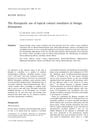Dermoscopy of Chronic Radiation-Induced Dermatitis in Patients with Head and Neck Cancers Treated with Radiotherapy
March 2024
in “
Life
”
TLDR Dermoscopy can help assess the severity of chronic radiation-induced skin damage in head and neck cancer patients.
This study examines the dermoscopic features of chronic radiation-induced dermatitis (CRD) in 32 patients with head and neck cancers treated with radiotherapy. It identifies significant dermoscopic changes in irradiated skin, such as dotted vessels, yellow and brown scales, and white structureless areas, which are more prevalent in higher grades of CRD. The study also notes that age, gender, and concurrent chemotherapy significantly influence CRD development, with women more prone to pigmentation changes and concurrent chemotherapy increasing the risk of complete hair loss by over 6 times. Despite the small sample size, the research suggests that dermoscopy could be a valuable tool for assessing CRD severity and guiding future treatments, though further studies are needed to validate these findings.




